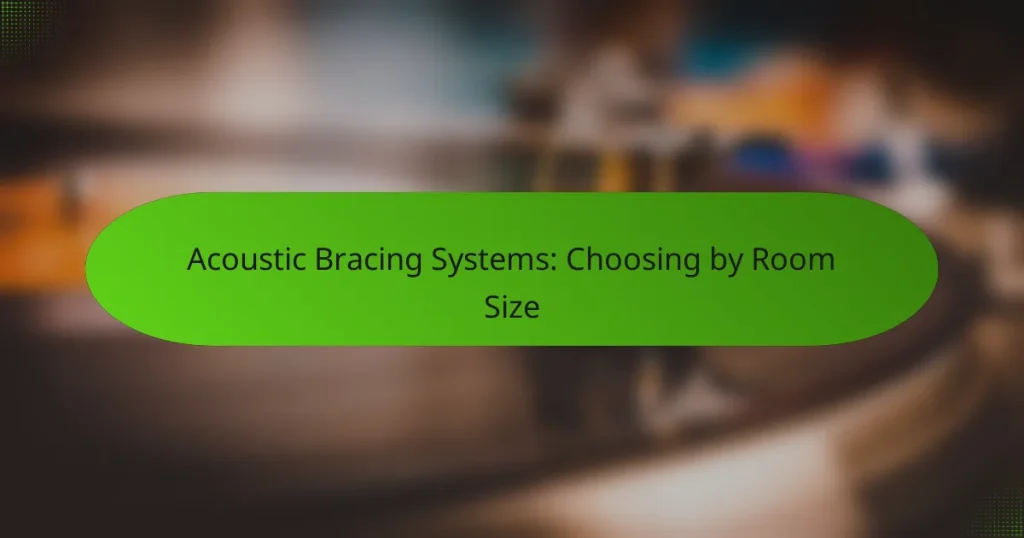Choosing the right acoustic bracing system is essential for enhancing sound quality and minimizing noise in various environments, from recording studios to residential spaces. With options like Roxul Rockboard 80 and Owens Corning 703, each system offers unique benefits tailored to different needs. Consider factors such as material types, installation ease, and cost-effectiveness to find the best fit for your acoustic requirements.
Acoustic Bracing Systems: User Reviews for Home Studios
Acoustic Bracing Systems: Budget Options and Comparisons
Acoustic Bracing Systems: Choosing by Room Size
Acoustic Bracing Systems: Key Features for Home Use
Acoustic Bracing Systems: Brand Comparison and Value
What are the best acoustic bracing systems available?
The best acoustic bracing systems combine effective sound absorption with ease of installation and versatility. Key options include Roxul Rockboard 80, Owens Corning 703, Acoustic Geometry, Primacoustic Broadway Panels, and Sonex Acoustic Panels, each offering unique benefits for different environments.
Roxul Rockboard 80
Roxul Rockboard 80 is a mineral wool insulation product known for its excellent sound absorption properties. It is particularly effective in controlling mid to high-frequency sounds, making it ideal for studios and home theaters.
This material is fire-resistant and can be used in various applications, including wall cavities and ceilings. When installing, ensure proper sealing to maximize its acoustic performance.
Owens Corning 703
Owens Corning 703 is a fiberglass acoustic panel that excels in sound absorption across a broad frequency range. It is lightweight, making it easy to handle and install in various settings, from recording studios to offices.
This panel is available in different thicknesses, allowing for customization based on specific acoustic needs. Consider using it in conjunction with other materials for optimal sound control.
Acoustic Geometry
Acoustic Geometry offers a range of innovative acoustic solutions, including custom panels and diffusers designed to enhance sound quality. Their products are often tailored to specific environments, ensuring effective sound management.
When selecting Acoustic Geometry products, consider the specific acoustic challenges of your space. Their designs often incorporate aesthetic elements, allowing for both functionality and visual appeal.
Primacoustic Broadway Panels
Primacoustic Broadway Panels are designed for high-performance sound absorption and are suitable for both commercial and residential applications. These panels are made from high-density fiberglass and are available in various colors and sizes.
They are easy to install and can be mounted directly to walls or ceilings. For best results, place them strategically in areas where sound reflection is most problematic.
Sonex Acoustic Panels
Sonex Acoustic Panels are made from melamine foam and are known for their lightweight and effective sound absorption capabilities. They are particularly useful in environments where aesthetics are important, as they come in various colors and shapes.
These panels are easy to install using adhesive or mechanical fasteners. Ensure that you cover enough surface area to achieve significant sound reduction, especially in larger spaces.
How do acoustic bracing systems work?
Acoustic bracing systems function by reducing sound transmission and vibration through various materials and techniques. They are designed to enhance sound quality and minimize noise in various environments, such as recording studios, theaters, and residential spaces.
Sound absorption principles
Sound absorption involves materials that convert sound energy into heat, thereby reducing echo and reverberation. Common materials used for sound absorption include foam panels, carpets, and heavy curtains, which can significantly lower noise levels in a room.
When selecting sound-absorbing materials, consider their Noise Reduction Coefficient (NRC) ratings, which typically range from 0 to 1. An NRC of 0.5 indicates moderate absorption, while a rating closer to 1 signifies high effectiveness in dampening sound. For optimal results, use a combination of materials to target different frequencies.
Vibration damping techniques
Vibration damping techniques aim to minimize the transmission of vibrations through structures. This can be achieved using materials like viscoelastic compounds, which absorb and dissipate vibrational energy, or by employing isolation mounts that separate vibrating components from the surrounding structure.
When implementing vibration damping, consider the specific frequencies you need to address. For example, lower frequencies may require denser materials, while higher frequencies can often be managed with lighter, more flexible solutions. Always ensure that the chosen damping method complies with local building codes and standards for safety and effectiveness.
What factors should you consider when choosing an acoustic bracing system?
When selecting an acoustic bracing system, consider material types, installation requirements, and cost-effectiveness. Each factor plays a crucial role in determining the overall performance and suitability for your specific needs.
Material types
The choice of material significantly impacts the effectiveness of an acoustic bracing system. Common materials include wood, metal, and composite options, each offering different sound-dampening properties. For instance, wood is often favored for its natural acoustic qualities, while metal may provide greater durability.
Evaluate the acoustic performance ratings of materials, which can vary widely. For example, materials with higher density generally offer better sound isolation. Consider your environment and the specific sounds you need to mitigate when choosing a material.
Installation requirements
Installation requirements can vary based on the complexity of the acoustic bracing system. Some systems may require professional installation, especially if they involve structural modifications, while others can be installed by DIY enthusiasts. Always check the manufacturer’s guidelines for specific installation instructions.
Consider the time and tools needed for installation. Systems that are easier to install might save on labor costs but could compromise performance if not done correctly. Ensure you have the right equipment and skills before proceeding with installation.
Cost-effectiveness
Cost-effectiveness is a critical factor when choosing an acoustic bracing system. Prices can range from a few hundred to several thousand dollars, depending on the materials and complexity of the system. Assess your budget and weigh it against the expected benefits in sound reduction.
Look for systems that offer a balance between initial investment and long-term performance. Sometimes, spending slightly more upfront on a high-quality system can lead to better soundproofing and lower maintenance costs over time. Always compare options and consider potential savings on energy or noise-related issues in your space.
What are the advantages of using acoustic bracing systems in studios?
Acoustic bracing systems offer significant benefits for studios by enhancing sound quality and recording clarity. These systems help to minimize unwanted vibrations and resonances, leading to a more controlled acoustic environment.
Improved sound quality
Acoustic bracing systems improve sound quality by reducing the transmission of vibrations that can distort audio signals. By strategically placing braces, studios can dampen low-frequency noise and enhance the overall tonal balance of recordings.
For instance, using materials like fiberglass or foam in the bracing can absorb sound energy, preventing it from bouncing off walls and creating muddiness. This results in clearer, more defined audio tracks that are easier to mix and master.
Enhanced recording clarity
Recording clarity is significantly enhanced with acoustic bracing systems, as they help isolate sound sources from external noise. This isolation allows for more precise capturing of vocals and instruments, leading to a professional-quality sound.
To achieve optimal clarity, consider using adjustable braces that can be tailored to specific studio layouts. This flexibility allows for better control over sound reflections and can accommodate various recording setups, ensuring that each session meets high standards.
How do acoustic bracing systems compare in terms of pricing?
Acoustic bracing systems vary significantly in pricing based on their design, materials, and intended application. Budget-friendly options can start in the low hundreds, while premium systems may reach several thousand dollars, depending on features and performance.
Budget-friendly options
Budget-friendly acoustic bracing systems typically range from around $100 to $500. These options often use simpler materials and designs, making them accessible for smaller projects or personal use. They may be suitable for residential applications or small studios where high-end soundproofing is not critical.
When considering budget options, look for systems that still meet basic sound isolation standards. Common pitfalls include underestimating the need for installation quality, which can affect overall performance. Always check user reviews and ratings to gauge effectiveness.
Premium systems
Premium acoustic bracing systems can range from $1,000 to over $5,000, offering advanced features such as enhanced sound absorption and durability. These systems are often designed for commercial applications, professional studios, or environments requiring stringent acoustic performance.
Investing in a premium system can yield significant benefits, including better sound quality and compliance with industry standards. However, ensure that the installation is handled by professionals to maximize performance. Consider the long-term value and potential return on investment when selecting a high-end option.
What are the installation steps for acoustic bracing systems?
The installation of acoustic bracing systems involves several key steps to ensure optimal soundproofing and structural integrity. Proper preparation, mounting techniques, and adherence to safety standards are essential for effective installation.
Preparation and planning
Before installation, assess the area where the acoustic bracing system will be placed. Consider factors such as room dimensions, existing structures, and soundproofing requirements. Create a detailed plan that includes the type of materials needed and the layout of the bracing system.
Gather necessary tools and materials, including brackets, screws, and acoustic panels. Ensure that all components meet local building codes and standards for sound insulation. A checklist can help keep track of items needed for installation.
Mounting techniques
Mounting techniques vary based on the type of acoustic bracing system being installed. Common methods include direct attachment to walls or ceilings using brackets and screws, or using a suspended framework for larger installations. Ensure that the mounting is secure to prevent any movement that could compromise soundproofing.
When mounting, maintain consistent spacing between braces to enhance sound absorption and structural support. Use a level to ensure that all components are aligned properly. Double-check that all fasteners are tightened to avoid future issues with stability or sound leakage.
What are common misconceptions about acoustic bracing systems?
Many people misunderstand acoustic bracing systems, believing they are solely for soundproofing or that all systems perform equally. In reality, these systems vary significantly in design, effectiveness, and application, making it crucial to choose the right one for your specific needs.
Effectiveness myths
A common myth is that all acoustic bracing systems provide the same level of sound isolation. In truth, effectiveness can vary based on materials used, installation methods, and the specific acoustic environment. For instance, some systems may excel in high-frequency noise reduction while being less effective against low-frequency sounds.
Another misconception is that thicker materials always yield better soundproofing. While density can contribute to sound dampening, the overall design and integration of the bracing system play a more critical role. For example, a well-designed lightweight system may outperform a poorly designed heavy one.
When selecting an acoustic bracing system, consider factors such as the type of noise you need to mitigate, the space’s dimensions, and any applicable building codes. It’s essential to consult with professionals to assess your specific situation and avoid common pitfalls, such as overestimating the capabilities of a system based solely on its thickness or material type.





